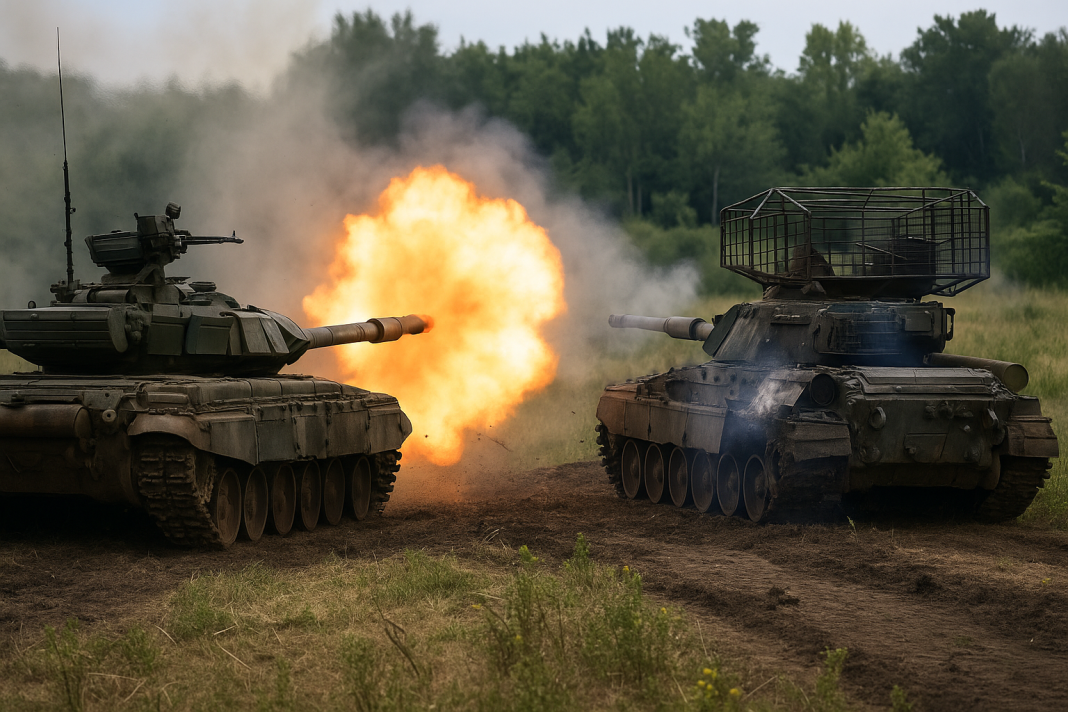A dramatic tank-on-tank showdown unfolded just outside the front-line town of Siversk in eastern Ukraine this week, highlighting the evolving nature of the battlefield and the growing confidence of Ukrainian forces in close combat situations.
The incident, captured on video by a military blogger known as “Myslyvets za zoriamy,” shows a Ukrainian tank from the 54th Separate Mechanized Brigade engaging a Russian armored vehicle at extremely close range—less than 100 meters. According to the footage, the Russian tank was equipped with an improvised protective structure designed to defend against drone attacks, a growing threat to armored forces on both sides.
Despite the Russian tank’s defenses, the Ukrainian crew fired a direct hit with their main gun using what is believed to be a cumulative round—a type of shell designed to pierce armor. The strike hit the top section of the vehicle and caused significant damage, although it wasn’t enough to completely disable the Russian tank, which managed to pull back under its own power.
The video cuts off before revealing the final outcome, but according to the blogger who posted the footage, the damaged Russian vehicle was later finished off by a loitering munition (a type of drone that searches for and attacks targets on its own) as it attempted to retreat.
🔥 Russia’s war machine takes a hit as Ukrainian drones strike Nevinnomyssk chemical facility
🚩 How the Battle Unfolded Near Siversk
The tank encounter happened roughly two kilometers outside Siversk, a key town currently held by Ukraine’s 54th and 53rd Mechanized Brigades, as well as the National Guard’s elite 4th Rapid Response Brigade “Rubizh.” The region has seen intense fighting in recent weeks, especially as Russian forces attempt to regain momentum in their stalled offensive.
The Russian tank involved in the skirmish appeared to be of the same type that participated in a larger assault on July 25, which was repelled by Ukrainian units from the 54th and 81st Brigades. At that time, several Russian tanks were spotted with strange-looking cages and protective frames mounted on their roofs and sides. These add-ons, sometimes called “cope cages,” are meant to shield against drone attacks—but in reality, they often provide little actual protection.
In this latest engagement, the Ukrainian crew’s ability to score a hit at such a close range speaks volumes about their training, nerves, and battlefield awareness. Tanks are usually designed to engage targets at distances of hundreds, even thousands, of meters. To fire from less than 100 meters suggests the clash occurred in very tight terrain—possibly forested areas, ruined buildings, or narrow corridors of movement.
The cumulative shell used in the attack is specifically engineered to punch through thick armor using focused explosive energy. While the Russian tank survived the initial hit, it was clearly damaged enough to require withdrawal, showing again how vulnerable even the most heavily armored vehicles can be when caught in the wrong place at the wrong time.
🔐 Ukraine wipes Gazprom’s core systems in massive cyber blitz—servers destroyed, 390 branches hit
🛡️ Why Russian Tanks Keep Failing Against Ukraine’s Growing Arsenal
In the early stages of the war, Russia had a massive advantage in armored firepower. Estimates suggested that they had up to ten times more tanks and armored combat vehicles than Ukraine. That advantage, however, has been steadily eroding.
One of the main reasons is Ukraine’s rapid development and deployment of drone warfare. Over the past two years, Ukrainian engineers and soldiers have adapted commercial drones into deadly tools of war, using them to drop explosives or fly directly into enemy vehicles. At the same time, more advanced military-grade loitering munitions have become a major part of Ukraine’s defense strategy.
The effectiveness of these tools has been staggering. As of mid-2025, Ukraine’s General Staff reported that close to 10,000 Russian tanks had been destroyed since the full-scale invasion began in 2022. While not all of those losses were confirmed independently, the number is backed by extensive drone footage, satellite imagery, and independent tracking groups.
In response, Russian troops have begun adding makeshift protective structures to their vehicles. These range from steel cages and wire mesh to slabs of reactive armor. While these additions may offer some resistance to drones, they also slow down vehicles, reduce visibility, and don’t stop direct hits from tank rounds or precision munitions.
It’s become increasingly clear that Russian forces no longer have full confidence in their armored vehicles. Tank crews now rely heavily on protective modifications and often avoid aggressive maneuvers, fearing devastating strikes from above or well-planned Ukrainian ambushes.
In contrast, Ukrainian tank crews have gained battlefield confidence, especially in areas where they hold the advantage. With better coordination, real-time drone support, and superior knowledge of the terrain, they are increasingly able to take the fight directly to enemy units—even at point-blank range.
🧪 Green Hope, Toxic Roots—War-Torn Ukraine’s Surprise Forest Grows Over Chemical Time Bomb
🧭 What This Means for the Next Phase of the War
This close-range tank duel near Siversk is just one of thousands of small engagements taking place daily across Ukraine’s eastern front, but it carries significant implications. It shows that Ukraine’s frontline units are not only holding their ground—they’re adapting, innovating, and taking calculated risks that yield strategic results.
As Ukraine continues to refine its combined-arms tactics, including drone reconnaissance, precision artillery, and maneuver warfare, Russian forces may find themselves on the back foot more often—especially if their armored units continue to suffer high losses.
While the war is far from over and both sides continue to endure immense hardships, moments like these remind the world that smaller, better-coordinated forces can outmaneuver even the most heavily armed adversaries.

